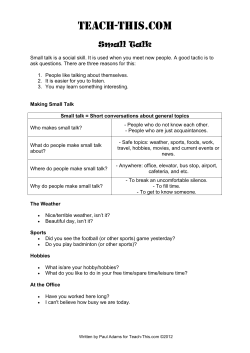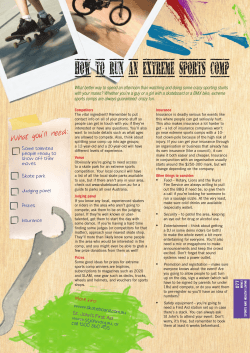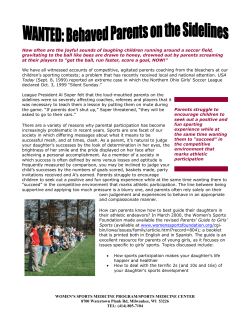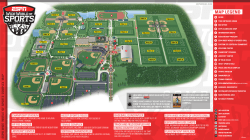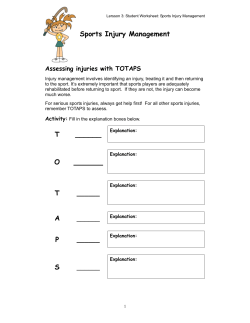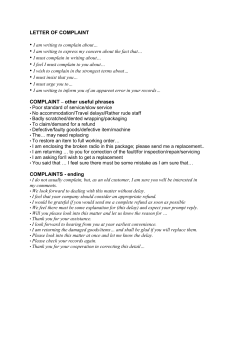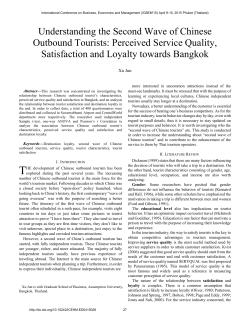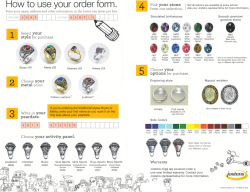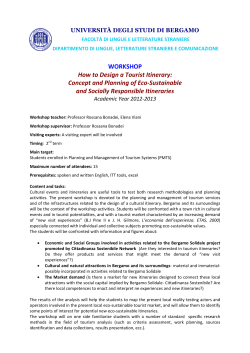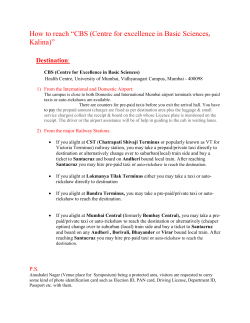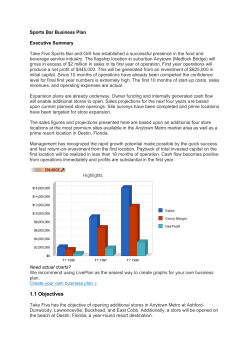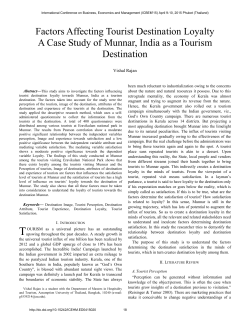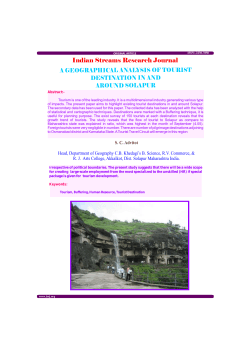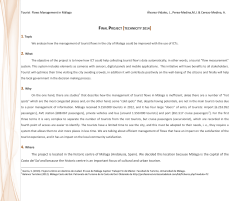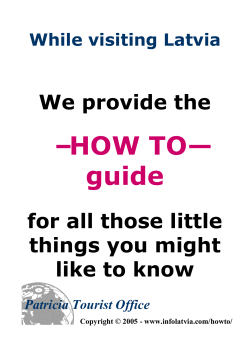
HOW TO USE SPORTS TOURISTS’ INFRASTRUCTURES TO DEVELOP DESTINATION BRANDS
HOW TO USE SPORTS TOURISTS’ INFRASTRUCTURES TO DEVELOP DESTINATION BRANDS Yfantidou Georgia, Costa George, Michalopoulou Maria Department of Physical Education and Sport Science, Democritus University of Thrace, Greece Aim of abstract/paper - research question The aim of the present study was the creation of a frame which could be used for the evaluation and categorization in sports tourists’ infrastructures and to reveal the components (behavior, motivation, destination characteristics, socio-demographic data) for an affective and cognitive image for sports tourist destination branding. The present research will explore if tourist behavior is depended on gender, age and motivation. Theoretical background or literature review The construction of a sports facility requires rational planning with concrete process and successive stages. The philosophy of owners of each organization and the aim of facility determines each use. The place selection for the construction of the sports facility must depend on the evaluation of certain factors. Destination branding is a new way to promote better your product / destination / sports. It is very important to know how to do it. Also it is difficult to be approached and explained because of the complexity of concepts that are involved. The present study will reveal the components for an affective and cognitive image for sports tourist destination brands based on the research of Beerli and Martin (2004), who indicated that: (1) motivations influence the affective component of image; (2) the experience of vacation travel has a significant relationship with cognitive and affective images, and (3) the socio-demographic characteristics influence the cognitive and affective assessment of image. The destination image exerts a mediating role between the three image components (cognitive, unique and affective) as the brand associations and the behavioral intentions (Qu et al., 2011). Cai et al. (2009), assert that academic research in destination branding has used the concept of image formation as synonymous with branding. Accordingly, image formation encapsulated by slogans is an operational approach to destination promotion whereas destination branding is a strategic management process. If a discussion is opened about the main reason for practicing destination branding, only one conclusion will arrive; to build a desirable image that can attract tourists; to differentiate one’s destination from competitors and position it to attract higher spending tourists; to manage image; and to make one’s destination a better place to live by increasing the economic contribution of tourism (Park and Petrick, 2006). Methodology, research design and data analysis Sample: Data consisted of a stratified sample by age and gender of 1675 tourists from fifty countries who visited Greece in summer (June-July-August 2007). This method was used in order to have as many men as women at each age group. The second sample of the study was 317 people in Cyprus. Measurement tools: The questionnaire is based on the “Tourist Roles Preference Scale” of Gibson and Yiannakis (2002), and was translated in Greek, German and Russian. Having the questionnaire in four languages covered the majority of tourists who visited Greece. Also five questionnaires were developed for the creation of a theoretical frame that would best satisfy the infrastructures of sports tourism. Important information was gathered by: individuals with regard to the particular infrastructure, from the personal observation of the researchers at the sports infrastructures, from bibliographic information relative with the urban legislation, the existing classification of tourist lodgings based on the international rating system “stars” and according to the specifications which were determined by each relative world federation. Procedure: The questionnaires were distributed at the two main airports in Greece: Eleftherios Venizelos at the city of Athens and Macedonia airport at the city of Thessaloniki. Because of the functional difficulty of investigation of each sports facility for the second survey, the researchers selected the above sports centers because the Cyprus Tourism Organization at its site promoted most these sports www.visitcyprus.com. Results, discussion and implications/conclusions For the examination of predicting sports’ tourist role destination preference, binary logistic regression was used according to gender, age and 22 psychological needs that reflect their motives by step wise method. The most important results are shown bellow. Explorer. Prefers adventure travel, exploring out of the way places and enjoys challenges involved in getting there (outdoor sports). The needs that determine this tourist role preference for men 17 to 39 years of age are: a) safety and personal security needs, b) the need for health and well being, c) the need to have control over events and circumstances in your life, d) the need for growth, self discovery, self actualization, e) the need to be occasionally taken care by someone else. For men 40-59 years of age the needs that determine this tourist role preference are: a) Sexual needs and b) the need for esteem, prestige, status. The needs that determine this tourist role preference for women 17 to 39 years of age are: a) Sexual needs, b) the need for home and/or family, c) the need for growth, self discovery, self actualization and e) the need for creativity, self expression. Thrill Seeker. Interested in risky, exhilarating activities which provide emotional highs (extreme sports). The needs that determine this tourist role preference for men 17 to 39 years of age are: a) the need for freedom, autonomy, independence and b) sexual needs. But the need that keeps them back is the need for home and/or family. The needs that determine this tourist role preference for women 17 to 39 years of age are: a) the need for freedom, autonomy, independence, b) the need for variety, excitement, stimulation, c) the need to play and have a good time, d) the need to feel good about yourself, e) the need for creativity, self expression, f) the need for growth, self discovery, self actualization, g) the need to be occasionally taken care by someone else, h) the need for solitude, privacy and i) the need to have control over events and circumstances in your life. Active Sports Tourist. Primary emphasis while on vacation is to remain active engaging in favorite sports, attend events, even hunting or fishing. The needs that determine this tourist role preference for men 17 to 39 years of age are: a) safety and personal security needs, b) the need for health and well being, c) the need to have control over events and circumstances in your life, d) the need for growth, self discovery, self actualization and e) the need to be occasionally taken care by someone else. But, the needs that force them back are: a) the need for love and affection, b) the need for variety, excitement, stimulation and c) the need to feel connected with one’s history, roots, the past. From the second survey the results revealed ten factors for the general questionnaire. One factor was revealed for football infrastructures (Criteria of quality requirements of football centers a=.79), one for the swimming infrastructures (Criteria of quality requirements of swimming centers a=.85), three factors for cycling (Basic functional criteria of cycling routes eigenvalue: 3.7, a= .90 and 31.5 % of variance, Facilitation criteria eigenvalue: 2.6, a= .72 and 22.1 % of variance, Criteria of cases of contingencies eigenvalue: 1.4, a= .53 and 11.8 % of variance) and four factors for scuba diving (Facilitation criteria eigenvalue: 2.5, a= .70 and 19.33 % of variance, Information and service criteria eigenvalue: 2.4, a= .60 and 18.69 % of variance, Safety criteria eigenvalue: 1.9, a= .53 and 14.68 % of variance, Additional services criteria eigenvalue: 1.7, a= .54 and 13.1 % of variance). This research revealed the components for sports tourist destination brands: roles / behavior, needs / motivation, destination characteristics, sports tourist profile / socio-demographic data. All three sports tourist roles have the same preferences at destination characteristics, that is undeveloped, inland, novel, inexpensive, quiet, cold, exclusive, foreign, calming, familiar destination, adult oriented, risky, close to home, indoors/hotel, urban, passive, artificial environment, deserted, man made place, primitive, inaccessible. The development of criteria and specifications for the infrastructures of sports tourism creates positive results as much for the local organizations and businesses as for the interested tourists / users, once the businessman / organization could measure the demands and the needs which must satisfy to attract the specific category of sports tourists and from the other hand, the customer / sports tourist could be informed at a satisfying level about the services which will be provided to him / her and to decide about the money value of the services at each sports facility. References Beerli, A. & Martın, J. (2004). Tourists’ characteristics and the perceived image of tourist destinations: a quantitative analysis - a case study of Lanzarote, Spain. Tourism Management, 25, 623-636. doi:10.1016/j.tourman.2003.06.004 Cai, L. (2002). Cooperative branding for rural destinations. Annals of Tourism Research,, 29( 3),. 720–742. Gibson, H. & Yiannakis, A. (2002). Tourist roles. Needs and the lifecourse. Annals of Tourism Research, 29(2), 358-383. Park, S.-Y. & Petrick, J. (2006). Destinations’ Perspectives of Branding. Annals of Tourism Research, 33(1), 262–265. Qu, H., Hyunjung Kim, L. & Hyunjung Im, H. (2011). A model of destination branding: Integrating the concepts of the branding and destination image. Tourism Management, 32, 465-476.
© Copyright 2025
